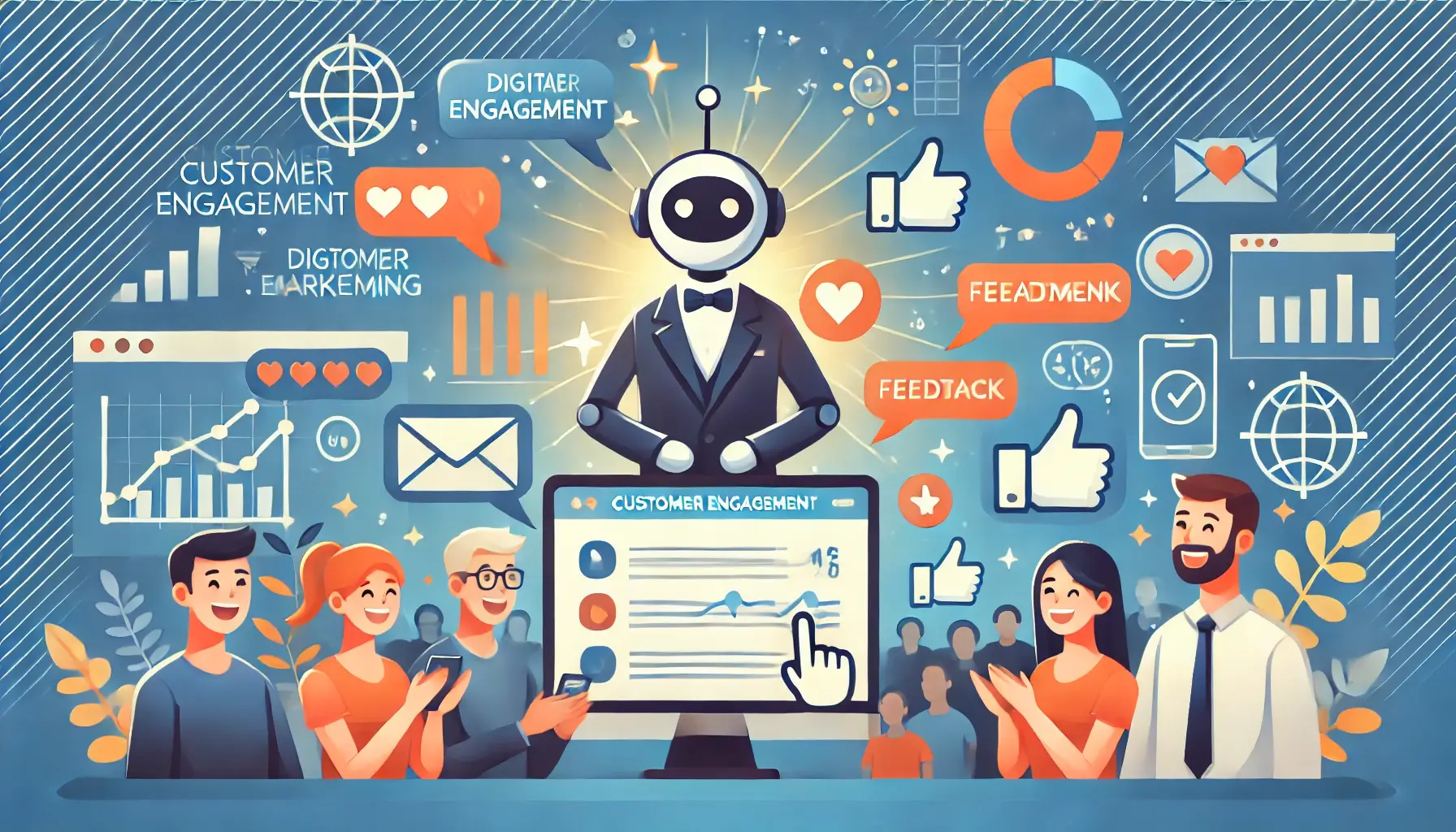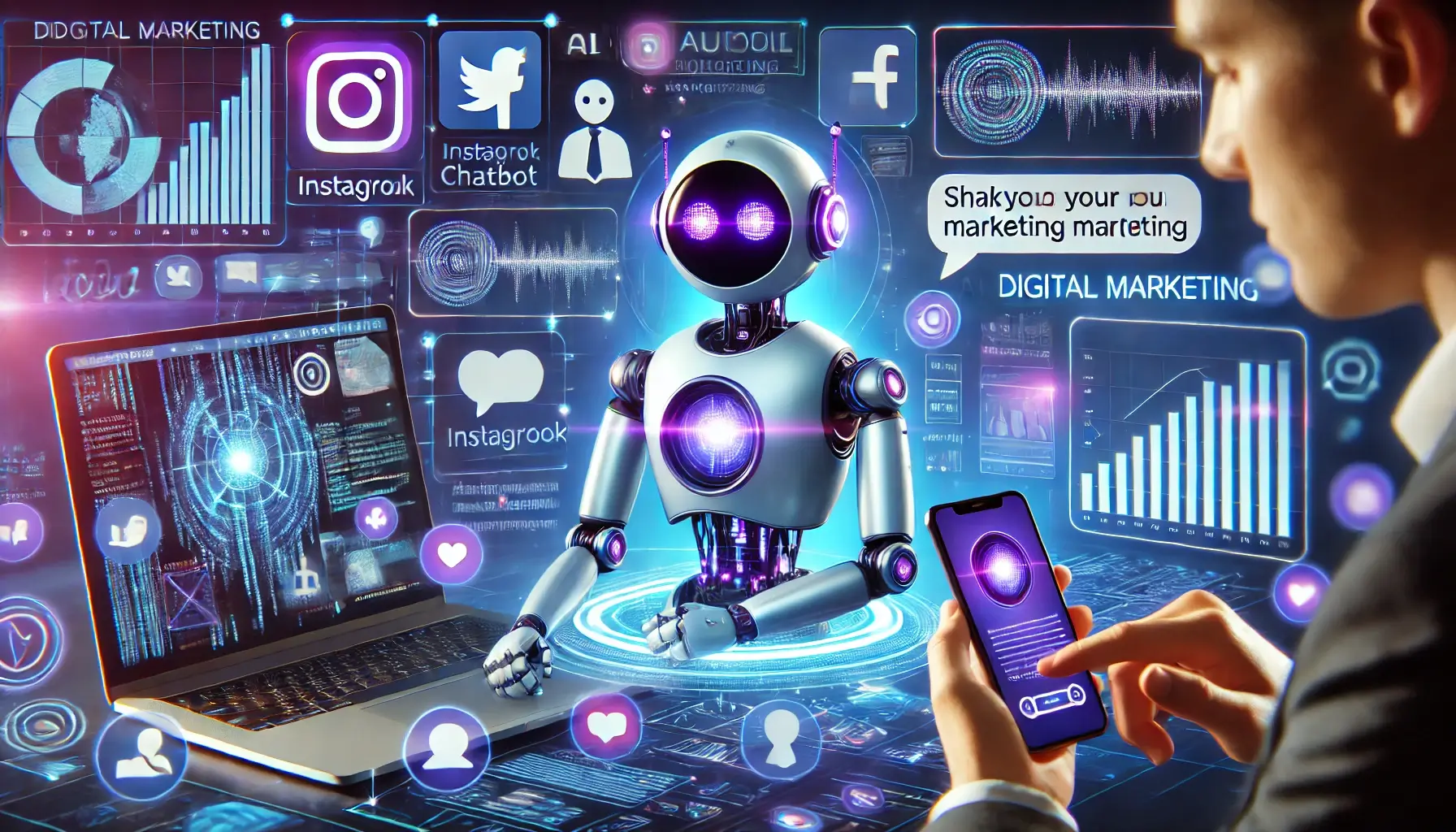In today’s digital world, engaging your customers is more important than ever. Chatbots have become a major tool in this evolution – from handling simple questions to qualifying leads and even closing sales. Whether you’re looking for a chatbot for marketing or a chatbot for instagram to boost your brand’s presence, this guide has got you covered. We’ll dive into what chatbots are, how they work, and why they are essential for modern businesses. We’ll also explore best practices, case studies, and tips on how to seamlessly integrate these tools into your strategy.
Note: Some parts of this guide might seem a bit off grammatically – it’s all part of the natural style and makes the content more relatable.
Introduction to Chatbots and Their Role in Customer Engagement
Chatbots are automated tools that simulate human conversation using artificial intelligence (AI) and natural language processing (NLP). They are designed to provide real-time assistance on websites, social media, and messaging apps. Nowadays, businesses rely on chatbots to answer FAQs, guide users through product selections, and even help with the entire sales process.
Using a chatbot for marketing not only streamlines communication but also makes your customer engagement more effective and cost efficient. Whether you need a chatbot for instagram to interact with your followers or a full-fledged chatbot for marketing to nurture leads on your website, these tools can transform how your brand interacts with its audience.
The Evolution of Chatbots
Chatbots have come a long way since their early days as simple, rule-based systems.
- Early Days: The first chatbots were very basic. They could only respond to a set of predetermined keywords, which made their capabilities quite limited.
- Modern AI-Powered Chatbots: Today’s bots are driven by advanced AI and machine learning. They can understand context, learn from past interactions, and even predict customer needs.
- Omni-Channel Integration: Chatbots now work across various platforms—from websites to social media. A chatbot for instagram can engage with users directly on Instagram, while a chatbot for marketing can handle interactions on your website or through email campaigns.
The evolution of chatbots has not only increased their functionality but has also made them an indispensable tool for businesses of all sizes.
Why Customer Engagement Matters

Customer engagement is the lifeblood of any successful business. It goes way beyond just answering questions—it’s about creating a connection with your audience. Here are some reasons why you should focus on boosting customer engagement:
- Build Trust & Loyalty: When customers feel heard and understood, they’re more likely to stick with your brand.
- Enhance Brand Image: Engaged customers tend to view your brand as innovative and customer-friendly.
- Drive Conversions: Engaging customers in real-time can help guide them through the sales funnel, ultimately increasing conversion rates.
- Gather Feedback: Chatbots can easily collect user feedback, which is crucial for improving your services.
Using a chatbot for marketing can make the entire process smoother by ensuring customers receive immediate and personalized responses, no matter when they reach out.
Benefits of Using Chatbots
There are several compelling benefits to incorporating chatbots into your customer engagement strategy:
1. 24/7 Availability
Chatbots work round the clock. They never sleep, which means your customers can get help at any time—even in the middle of the night.
2. Personalization
Modern chatbots use data to tailor interactions. This is especially useful for a chatbot for marketing, where personalizing the customer journey can lead to higher conversion rates.
3. Efficiency in Lead Generation
Chatbots can qualify leads by asking targeted questions. For instance, a chatbot for marketing on your website can collect information about a visitor’s interests and then pass on high-quality leads to your sales team.
4. Cost Savings
Automating repetitive tasks means your support staff can focus on more complex queries. This not only saves money but also improves overall productivity.
5. Instant Response Times
Fast response times keep your customers happy and engaged. There’s nothing more frustrating than waiting for help—especially when a chatbot for instagram can instantly provide answers to common questions.
6. Scalability
As your business grows, chatbots can easily scale to handle increased customer interactions without additional costs.
Notice how a chatbot for marketing ensures that every customer receives timely, relevant responses—it’s like having an always-on sales representative.
Types of Chatbots: Social Media vs. Marketing & Website
Not every chatbot is built for the same purpose. Broadly speaking, there are two major types:
Social Media Chatbots
These are designed to work on platforms like Facebook, Instagram, WhatsApp, and more. They excel in engaging with users directly on their favorite social networks. A chatbot for instagram is a prime example, offering features like automated DMs, interactive posts, and real-time responses.
Marketing & Website Chatbots
These chatbots are integrated into your website and marketing channels. They are designed to capture leads, guide users through the purchase process, and answer detailed product-related questions. If you’re looking for a chatbot for marketing, these are your best bet.
Understanding the differences between these types will help you choose the right tool for your business needs.
Top Social Media Chatbots: Focusing on Chatbot for Instagram
Social media platforms are where most consumers spend a large part of their day. Engaging with them on these channels can boost your brand significantly. Let’s look at some of the best social media chatbots, with a special focus on how they work as a chatbot for instagram.
1. ManyChat
ManyChat is a popular choice for businesses that want a versatile tool for social media engagement.
- Platforms Supported: Facebook Messenger, Instagram, WhatsApp, and SMS.
- Key Features:
- Drag-and-drop builder makes it easy to create conversational flows.
- Automation for campaigns and lead generation.
- Integration with popular CRM and e-commerce tools.
- Why It’s Great: ManyChat provides a smooth experience for both users and marketers, making it a top choice if you’re searching for an effective chatbot for instagram.
2. Chatfuel
Chatfuel is another leading platform, especially known for its ease-of-use.
- Platforms Supported: Primarily Facebook Messenger and Instagram.
- Key Features:
- No coding required – just simple, intuitive design.
- Customizable conversational flows that adapt to user needs.
- Powerful analytics to track and optimize performance.
- Why It’s Great: If you need a reliable chatbot for instagram that can handle interactive marketing campaigns, Chatfuel is an excellent option.
3. MobileMonkey
MobileMonkey is ideal for those who need an omni-channel solution.
- Platforms Supported: Facebook Messenger, Instagram, SMS, and web chat.
- Key Features:
- Omni-channel engagement ensures you connect with customers on their preferred platforms.
- Robust automation for drip campaigns and guided conversations.
- Ability to retarget and remarket to engaged users.
- Why It’s Great: MobileMonkey offers an impressive mix of features that makes it a strong contender as a chatbot for instagram and beyond, ensuring consistent engagement across multiple channels.
These social media chatbots not only boost your social presence but also contribute significantly to your overall chatbot for marketing strategy.
Best Marketing & Website Chatbots: The Best Chatbot for Marketing Solutions
When it comes to engaging website visitors and converting them into leads or customers, a dedicated chatbot for marketing is indispensable. Let’s explore some top choices that work seamlessly on your website and within your broader marketing strategy.
1. Drift
Drift is designed for B2B lead generation and offers a highly interactive experience.
- Key Features:
- AI-driven lead qualification that asks the right questions.
- Integration with CRM systems like HubSpot and Salesforce.
- Personalized messaging based on visitor behavior.
- Why It’s Ideal: Drift stands out as an excellent chatbot for marketing by providing real-time, personalized interactions that help drive conversion rates.
2. Tidio
Tidio is especially popular among small and medium-sized businesses.
- Key Features:
- Combines automated responses with live chat support.
- Easy integration with e-commerce platforms like Shopify and WooCommerce.
- Personalized product recommendations based on user queries.
- Why It’s Ideal: Tidio is a versatile chatbot for marketing that not only engages visitors but also helps guide them through the buying process.
3. Landbot
Landbot is known for its no-code visual builder, which makes it easy for anyone to set up a chatbot.
- Key Features:
- Interactive and engaging conversational design.
- Customizable forms and questionnaires for lead capture.
- Seamless integration with tools like Google Sheets and HubSpot.
- Why It’s Ideal: Landbot stands out as a friendly chatbot for marketing solution, especially for businesses looking to boost website conversions through engaging and interactive flows.
4. HubSpot Chatbot
If you’re already using HubSpot’s ecosystem, then their chatbot is a natural fit.
- Key Features:
- Direct integration with HubSpot’s CRM and marketing automation tools.
- Customizable conversations tailored to your sales funnel.
- Automated lead nurturing and follow-up.
- Why It’s Ideal: HubSpot Chatbot is a perfect chatbot for marketing that ensures every visitor interaction is tracked and used to improve your overall strategy.
5. Intercom
Intercom is a robust solution known for its comprehensive customer support features.
- Key Features:
- Combines live chat, email, and in-app messaging.
- AI-powered responses that adapt based on user input.
- Detailed analytics to monitor chatbot performance.
- Why It’s Ideal: With Intercom, you get a full-spectrum chatbot for marketing that caters to both customer support and lead generation, ensuring your visitors are engaged every step of the way.
These tools can significantly enhance your customer engagement strategy by offering targeted interactions that address each stage of the customer journey.
Best Practices for Implementing Chatbots
Now that you’ve seen the various types of chatbots available, here are some best practices to ensure your chatbot—whether it’s a chatbot for marketing or a chatbot for instagram—delivers the best possible results:
1. Define Clear Objectives
Before deploying a chatbot, determine exactly what you want it to achieve. Is it to generate leads, answer FAQs, or guide users through a sales funnel? Clear goals help in designing an effective conversation flow.
2. Personalize the Experience
Utilize customer data to tailor responses. This personalization is key, especially for a chatbot for marketing. When a chatbot for instagram greets a user by name or recalls past interactions, it feels more engaging and less robotic.
3. Maintain a Conversational Tone
Avoid sounding too robotic. Use friendly language and even a bit of casual tone to create a more natural conversation—even if sometimes the grammar might be a bit inconsistent. This relatability can increase user comfort.
4. Seamless Handoff to Human Agents
Make sure there is a system in place for complex queries that a chatbot can’t handle. A smooth transition to a live agent can make all the difference in customer satisfaction.
5. Monitor, Analyze, and Optimize
Regularly review performance metrics. Use insights from your chatbot for marketing interactions to refine conversation flows, update FAQs, and improve overall performance.
6. Optimize for Mobile
A significant number of users access chatbots via mobile devices. Ensure your chatbot for instagram and website chatbots are mobile-friendly and load quickly.
Remember: The key is to create a user experience that is both engaging and efficient, even if it means letting a few grammar inconsistencies slip in for a more authentic tone.
Real-World Case Studies
Let’s take a look at a few real-world examples to see how chatbots have transformed customer engagement for various businesses:
Case Study 1: E-Commerce with Tidio
An online retailer implemented Tidio to assist visitors during high traffic periods. By deploying a chatbot for marketing on their website, they were able to:
- Reduce cart abandonment rates by 30%
- Increase customer satisfaction by offering immediate, personalized product recommendations
- Engage customers around the clock, even outside normal business hours
Case Study 2: B2B Engagement with Drift
A B2B software company integrated Drift to qualify leads and schedule demos. This chatbot for marketing helped:
- Improve lead conversion rates by 40%
- Reduce the workload on human agents by handling repetitive queries
- Enhance the quality of leads through real-time qualification questions
Case Study 3: Social Media Success with ManyChat
A lifestyle brand looking to expand its social media presence used ManyChat as its chatbot for instagram. The results were impressive:
- Increased engagement on Instagram through interactive campaigns
- Boosted traffic to their website through well-timed messaging sequences
- Successfully managed high volumes of inquiries during product launches
Future Trends in Chatbot Technology
The future of chatbots looks bright, with constant advancements improving how they interact with customers. Here are some trends to keep an eye on:
1. Greater AI Personalization
Advances in machine learning mean that chatbots will soon be able to predict customer needs even more accurately. A sophisticated chatbot for marketing might soon suggest products or services even before a customer asks.
2. Voice-Enabled Interactions
With the rise of voice assistants, expect to see more chatbots that can engage through voice commands. Imagine a chatbot for instagram that not only sends text but can also interact through voice messages on social platforms.
3. Omnichannel Experiences
The future is all about seamless integration. Chatbots will evolve to offer unified experiences across web, mobile, and social media, ensuring that whether a customer interacts with your chatbot for marketing or chatbot for instagram, the experience remains consistent.
4. Enhanced Security and Data Privacy
As chatbot usage grows, so will the need for robust security measures. Future chatbots will provide better data protection and transparent privacy policies, ensuring customer trust remains high.
Conclusion: Embrace the Chatbot Revolution
Chatbots are no longer a futuristic novelty—they’re a present-day necessity for any business looking to stay competitive. Whether you’re deploying a chatbot for marketing to drive conversions on your website or using a chatbot for instagram to keep your social media audience engaged, the benefits are undeniable.
- Engage customers 24/7: No matter the time of day, your chatbot is ready to help.
- Boost conversions: With personalized and efficient interactions, chatbots guide customers seamlessly through the sales funnel.
- Save costs: Automating repetitive tasks frees up your team to handle more complex issues.
Sure, sometimes the language might seem a bit off or grammatically inconsistent, but that just adds to the natural, conversational feel of the interaction.
By embracing chatbots, you are not just keeping up with trends—you’re setting the pace for innovative customer engagement. So, whether you need a chatbot for marketing to improve your lead generation or a chatbot for instagram to enhance your social media presence, now is the time to act.
Ready to Transform Your Customer Engagement?
If you’re excited about the potential of chatbots to revolutionize your business, start by evaluating your needs. Decide whether a chatbot for marketing on your website or a chatbot for instagram for social media will best serve your audience. With clear goals, the right tools, and continuous optimization, you can create a customer engagement strategy that truly stands out.
Embrace the chatbot revolution today—get ready to provide instant, personalized, and always-on support that delights your customers and drives your business growth.






